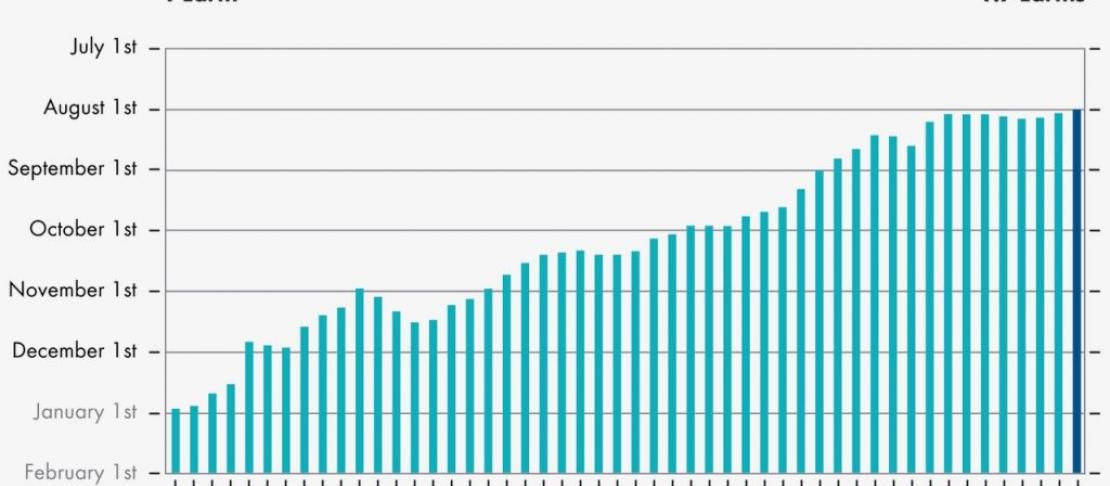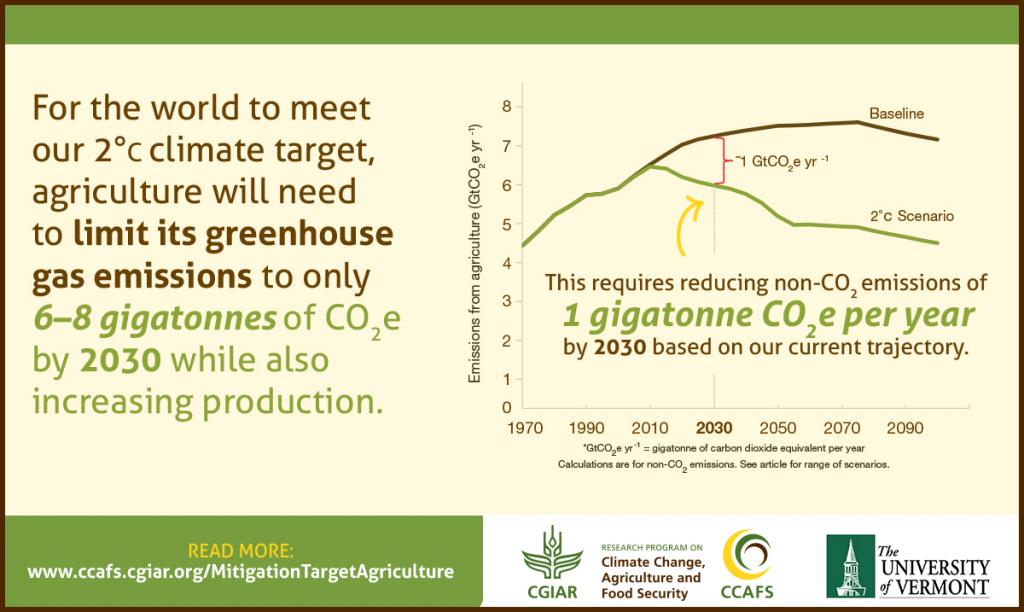Earth Overshoot Day comes earlier each year

To #movethedate, we need to shrink agriculture’s carbon footprint. But how?
From record-high low temperatures in Oman (42.6°C) in June to record-high high temperatures in Japan in July (41.1°C), extreme weather events this year—many linked to climate change—caused immediate deaths and widespread suffering. They also disrupted food production and are threatening medium-term food security.
Almost a quarter of anthropogenic greenhouse gas (GHG) emissions come from agriculture, principally from deforestation, livestock digestion and manure, irrigated rice, and chemical fertilizers. As demand for food production increases, limiting climate change urgently requires lowering emissions from our agriculture and food system. But how?
Climate stabilization scenarios require emission reductions in agriculture.
Source: Reducing emissions from agriculture to meet the 2°C target.
Climate-smart agriculture innovations work
Innovations in agricultural production often help us produce more food with fewer emissions, and such innovations spread quickly when they make economic sense for farmers. For example, allowing periodic drying of irrigated rice can reduce emissions by 48%. This and an associated bundle of practices, called alternate wetting and drying (AWD+), also save farmers money on irrigation and provide ecosystem services such as preserving ground water. Farmers in Bangladesh, China, the Philippines and Vietnam use AWD+ in many areas, and experts are developing suitability maps to guide scaling of AWD.
Another innovation is the use of nutrient sensors, which inform farmers on the quantity and type of fertilizer needed to maximize crop yields. Without this tool, farmers in countries like China, India, and Mexico tend to hedge their bets and maximize application of fertilizers, but the excess fertilizer doesn’t increase production so it wastes farmers’ money. The excess fertilizer also causes massive nitrous oxide emissions. In sub-Saharan Africa, on the other hand, farmers tend to spread fertilizer thinly to save money, but too thinly to optimize yields. Used on large farms in industrial countries since the 1970s, farmers in some countries now have access to lower-cost, hand-held monitors or pay a small amount for drones to capture data to guide fertilizer application. If we can enable not only nutrient sensors but a digital agriculture future, farmers will be able to maximize productivity and save money while minimizing emissions.
Globally, agriculture is the largest driver of deforestation, as forests are cleared or thinned to make room for agricultural production. Climate-smart agriculture decreases pressure on forests through improving productivity on existing agricultural lands and bringing degraded lands back into production. Supply chain initiatives, such as labeling, traceability and sustainability certifications for beef, coffee, and palm oil, have successfully slowed deforestation. Despite these advances, and despite the fact that forest gain is happening at high latitudes and in richer countries, deforestation peaked in 2016 and 2017 after 20 years of slowing. As governance of forest use tends to wax and wain in some countries with large swaths of forest, it is important that civil society continue to monitor and press for forest protection.
Climate-smart agriculture - which includes AWD+, nutrient management, and many other practices - works because it decreases emissions and benefits farmers and consumers. But without addressing several grand challenges (two that are described out below), we won’t be able to decrease agricultural emissions to a sustainable level.
Our food habits are a huge handicap to achieving sustainability.
The first challenge: we need to halve food loss and waste. Globally, a third of food is lost or wasted between harvest and consumption each year. Food loss and waste occurs in both developing and industrialized countries, though the point of loss or waste varies widely. Savings would feed millions, reduce pressure on forests, and decrease emissions from production. As consumers, governments, and private sector recognize that a circular economy is our future, work is underway to identify and implement methods to reduce loss and waste from production, transportation, storage, packaging and consumption in different food supply chains and systems.
The solution is a transformation in our food system.
As farmers, governments, and food and input companies benefit from a growing evidence-base on climate-smart agriculture, there is simultaneously significant progress and a huge gap. We must expand development and implementation of low-emission technical and policy interventions that will produce enough food to feed our growing global population and meet the needs of farmers. From the point of view of the consumer, the sooner we shift to low-emission diets and a circular economy, the better it will be for the climate and future generations.
We must address these and other challenges to transform the food and agriculture sector and to #movethedate.
Read more
- Website: Earth Overshoot Day
- Journal article: Agriculture production as a major driver of the Earth system exceeding planetary boundaries
- Journal article: Reducing emissions from agriculture to meet the 2°C target
- Website: Greenhouse gas mitigation in rice
- Journal article: Nitrous oxide flux responds exponentially to nitrogen fertilizer in irrigated wheat in the Yaqui Valley, Mexico
- Journal article: Agriculture-driven deforestation in the tropics from 1990-2015: emissions, trends and uncertainties
- Journal article: Climate change mitigation through intensified pasture management: Estimating greenhouse gas emissions on cattle farms in the Brazilian Amazon
The CGIAR Research Program on Climate Change, Agriculture and Food Security (CCAFS), led by the International Center for Tropical Agriculture (CIAT), brings together some of the world’s best researchers in agricultural science, development research, climate science and Earth System science, to identify and address the most important interactions, synergies and tradeoffs between climate change, agriculture and food security. CCAFS is carried out with support from CGIAR Fund Donors and through bilateral funding agreements.




